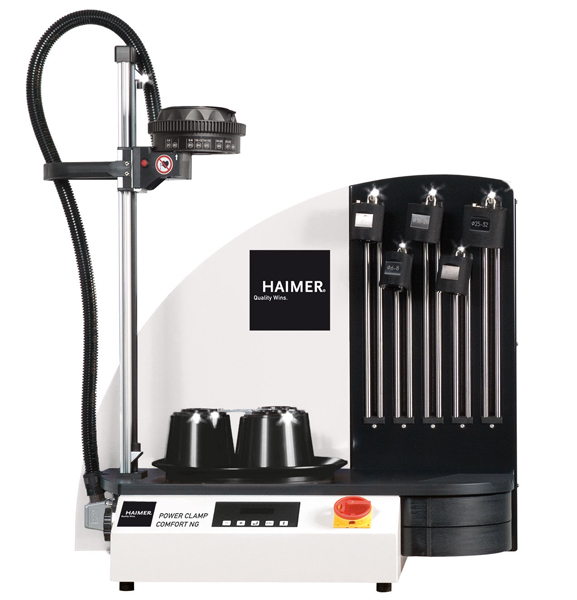 Making chips means making money, so keeping the spindle turning is critical for a company's bottom line.
Making chips means making money, so keeping the spindle turning is critical for a company's bottom line.
Timothy Mooney, Midwest regional sales manager for Starrag USA, distributors of high-precision machine tools, said his customers strive for a 75 percent spindle engagement time "That is the only time that they are making money."
Mooney spoke May 14 at the Haimer open house. The Villa Park, IL-based company showcased shrink fitters, balancers and presetters. Also featured at the May 14-16 event were demonstrations of i4.0 wireless connectivity between presetters and a machining center.
The technology is critical to long-running machine life. The aerospace industry, for example, utilizes electrospindles that can run up to 65000 RPM, with typical machining speed of 30,000 to 33,000 RPM. "Without a balanced tool, bearings are going to be shot before you know it and you will have a really expensive repair."
A crashed spindle may run up to $65,000, Mooney said, and an imbalanced tool will likely shorten spindle life. "Customers using balancers and high quality tool holders will achieve between 8,000 and 12,000 hours of spindle life," he said. "Customers that don't [use balancers] achieve closer to 3,000 to 4,000 spindle hours, and that assumes the tool is reasonably balanced."
Mooney added that "with Haimer tool holders, you are going to have a tool that runs true, a tool that is shrunk in properly, and a tool that is going to hold it."
At Haimer's event, one of newest such products on display was the "industry 4.0 ready" Power Clamp that is network compatible for communication on the shop floor. Tool scanning capabilities allow shrink fit machines to read and automatically set the shrinking parameters via Data-Matrix codes. It is suitable for solid carbide and HSS tools for diameters 3 to 32 mm.
Steven Baier, vice president of sales for Haimer said that the company's focus is providing customers with consistent tools, consistent holding forces, consistent tool runout. "Whether shrink fit tooling, balancing or tool presetting, our focus is giving our customers consistency of setup."
This can be seen in products such as the ShrinkFit. "Whether you are a brand new operator or a journeyman machining who has been on the job for 20 years, everybody changes the tools the same," he said. "With shrink fit, you always get three microns or one-tenth runout accuracy at 3x diameter of the cutter."
With presetting, tool runout can be checked outside the machine tool allowing for production to continue. As for the company's balancers, all tool holder assemblies have inherent unbalance and unless this is corrected, the unbalance will cause vibration.
"Vibration can only go to two places, up into your spindle or down into your part," Baier said. "At the very least, you're going to have a surface finish issue or a cutting tool issue. At the worst, a spindle failure because the bearings will wear out because of the vibration."
Contact Details
Related Glossary Terms
- high-speed steels ( HSS)
high-speed steels ( HSS)
Available in two major types: tungsten high-speed steels (designated by letter T having tungsten as the principal alloying element) and molybdenum high-speed steels (designated by letter M having molybdenum as the principal alloying element). The type T high-speed steels containing cobalt have higher wear resistance and greater red (hot) hardness, withstanding cutting temperature up to 1,100º F (590º C). The type T steels are used to fabricate metalcutting tools (milling cutters, drills, reamers and taps), woodworking tools, various types of punches and dies, ball and roller bearings. The type M steels are used for cutting tools and various types of dies.
- machining center
machining center
CNC machine tool capable of drilling, reaming, tapping, milling and boring. Normally comes with an automatic toolchanger. See automatic toolchanger.
- turning
turning
Workpiece is held in a chuck, mounted on a face plate or secured between centers and rotated while a cutting tool, normally a single-point tool, is fed into it along its periphery or across its end or face. Takes the form of straight turning (cutting along the periphery of the workpiece); taper turning (creating a taper); step turning (turning different-size diameters on the same work); chamfering (beveling an edge or shoulder); facing (cutting on an end); turning threads (usually external but can be internal); roughing (high-volume metal removal); and finishing (final light cuts). Performed on lathes, turning centers, chucking machines, automatic screw machines and similar machines.


